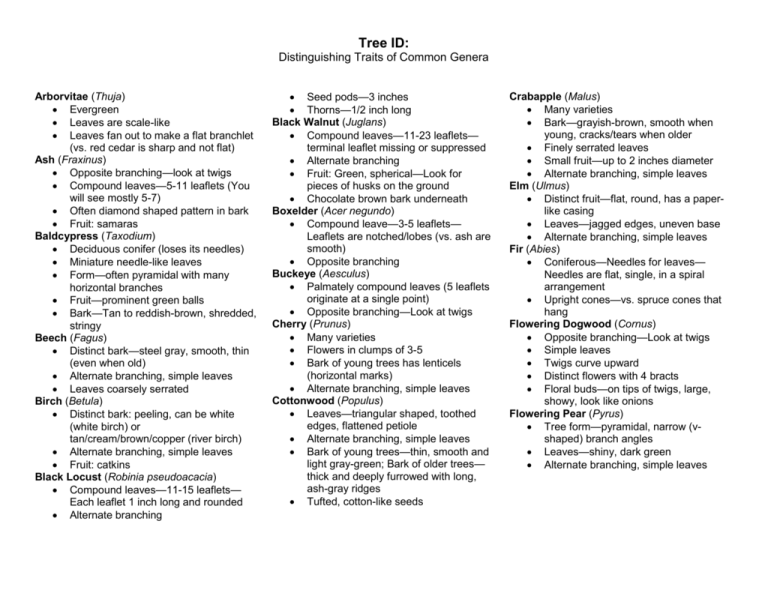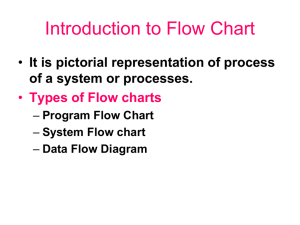Tree ID
advertisement

Tree ID: Distinguishing Traits of Common Genera Arborvitae (Thuja) Evergreen Leaves are scale-like Leaves fan out to make a flat branchlet (vs. red cedar is sharp and not flat) Ash (Fraxinus) Opposite branching—look at twigs Compound leaves—5-11 leaflets (You will see mostly 5-7) Often diamond shaped pattern in bark Fruit: samaras Baldcypress (Taxodium) Deciduous conifer (loses its needles) Miniature needle-like leaves Form—often pyramidal with many horizontal branches Fruit—prominent green balls Bark—Tan to reddish-brown, shredded, stringy Beech (Fagus) Distinct bark—steel gray, smooth, thin (even when old) Alternate branching, simple leaves Leaves coarsely serrated Birch (Betula) Distinct bark: peeling, can be white (white birch) or tan/cream/brown/copper (river birch) Alternate branching, simple leaves Fruit: catkins Black Locust (Robinia pseudoacacia) Compound leaves—11-15 leaflets— Each leaflet 1 inch long and rounded Alternate branching Seed pods—3 inches Thorns—1/2 inch long Black Walnut (Juglans) Compound leaves—11-23 leaflets— terminal leaflet missing or suppressed Alternate branching Fruit: Green, spherical—Look for pieces of husks on the ground Chocolate brown bark underneath Boxelder (Acer negundo) Compound leave—3-5 leaflets— Leaflets are notched/lobes (vs. ash are smooth) Opposite branching Buckeye (Aesculus) Palmately compound leaves (5 leaflets originate at a single point) Opposite branching—Look at twigs Cherry (Prunus) Many varieties Flowers in clumps of 3-5 Bark of young trees has lenticels (horizontal marks) Alternate branching, simple leaves Cottonwood (Populus) Leaves—triangular shaped, toothed edges, flattened petiole Alternate branching, simple leaves Bark of young trees—thin, smooth and light gray-green; Bark of older trees— thick and deeply furrowed with long, ash-gray ridges Tufted, cotton-like seeds Crabapple (Malus) Many varieties Bark—grayish-brown, smooth when young, cracks/tears when older Finely serrated leaves Small fruit—up to 2 inches diameter Alternate branching, simple leaves Elm (Ulmus) Distinct fruit—flat, round, has a paperlike casing Leaves—jagged edges, uneven base Alternate branching, simple leaves Fir (Abies) Coniferous—Needles for leaves— Needles are flat, single, in a spiral arrangement Upright cones—vs. spruce cones that hang Flowering Dogwood (Cornus) Opposite branching—Look at twigs Simple leaves Twigs curve upward Distinct flowers with 4 bracts Floral buds—on tips of twigs, large, showy, look like onions Flowering Pear (Pyrus) Tree form—pyramidal, narrow (vshaped) branch angles Leaves—shiny, dark green Alternate branching, simple leaves Tree ID: Distinguishing Traits of Common Genera Ginkgo (Ginkgo) Distinct leaf —fan shape, with a split in the center Leaves grown on pegs Alternate branching, simple leaves Hackberry (Celtis) Bark smooth to warty Simple leaves—Leaves have curved, asymmetrical base Alternate branching—zig-zag twigs Leaves often have nipple gall Fruit—dark purple sphere, 1/3 inch diameter Hawthorn (Crataegus) Small tree Many varieties—Nearly all have thorns Variable leaf shape – simple, combo of lobes and serrations Berry-like fruit—usually red/orange Flowers can be white, pink, or red. Hickory (Carya) Compound leaves—7-17 leaflets, leaflets are larger at terminal end of leaf Fruit—nut with a woody husk—Look for pieces on the ground Alternate branching Honeylocust (Gleditsia) Bark—dark red-brown and fairly smooth; on older trees it breaks into long, thin, flat, longitudinal ridges with curled edges. Doubly compound leaves—leaflets are about 1 inch long Alternate branching Linden (Tilia) Greenish-yellow leafy bract attached to flower/fruit Simple, alternate leaves—Heartshaped Magnolia (Magnolia) Flowers—Large, showy Bark—thin, smooth, gray Leaves—up to 12 inches long, glossy, underside sometimes a lighter color Alternate branching, simple leaves Maple (Acer) Simple leaves with pointed lobes (Canada flag) Opposite branching—Look at twigs Oak (Quercus) Leaves usually have distinct lobes o Some do not have lobes, such as Sawtooth oak, shingle oak, willow oak. Fruit—Acorns Alternate branching, simple leaves Pine (Pinus) Coniferous—Needles for leaves— Needles in groups of 2-5 Cones are rigid and woody compared to spruce Redbud (Cercis) Leaves—heart-shaped, simple Fruit—Seed pods Alternate branching—zig-zag twigs Redcedar (Juniperus) Coniferous—scale-like leaves Leaves are sharp, not flat like arborvitae Fruit—fleshy, berrylike Spruce (Picea) Coniferous—Needles for leaves— Needles are single Unlike fir, needles are not flat—can roll it in your finger Cones hang (vs upright on fir) Sweetgum (Liquidambar) Star-shaped leaves Fruit—Spikey gumball—Look for fruit on tree and ground Alternate branching, simple leaves Sycamore (Platanus) Bark—Unique, white/gray/green/brown, mottled, looks like camouflage Leaves—similar to maple leaf, 3-5 lobes Fruit—woody ball Alternate branching, simple leaves Tree-of-Heaven (Ailanthus) Compound leaves—Small gland bump on underside of each leaflet Stout twigs and large, heart-shaped leaf scar Grows like a weed Alternate branching Tuliptree, aka Tulip-Poplar (Liriodendron) Leaves—distinct shape—4 pointed lobes Flowers—tulip-like, greenish-yellow Fruit—cone-shaped cluster, persists on branches Alternate branching, simple leaves


![Branching Out: An Introduction to Family History [pptx , 2.3 MB]](http://s2.studylib.net/store/data/005232376_1-8bb1ea3bff509441ce8b545117622545-300x300.png)






